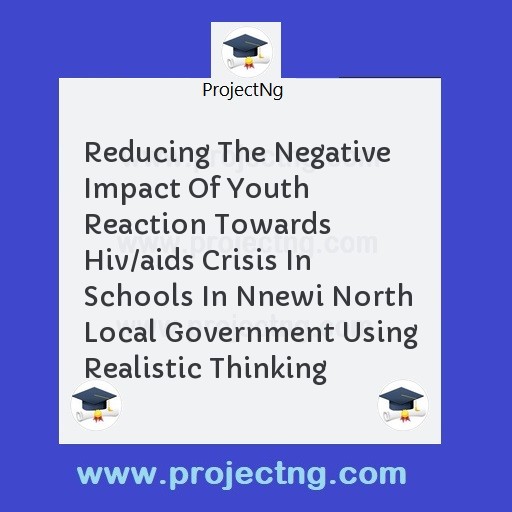Reducing The Negative Impact Of Youth Reaction Towards Hiv/aids Crisis In Schools In Nnewi North Local Government Using Realistic Thinking
Education Project Topics
Get the Complete Project Materials Now! »
REDUCING THE NEGATIVE IMPACT OF YOUTH REACTION TOWARDS HIV/AIDS CRISIS IN SCHOOLS IN NNEWI NORTH LOCAL GOVERNMENT USING REALISTIC THINKING
ABSTRACT
There has been a steady rise in the prevalence of HIV/AIDS in Nigeria. The stratum of the population most infected is those in secondary and tertiary school. In Nigeria, the government has shown political will and has set up a number of committees and activities to help curtail this epidemic. Some of the activities are aimed specifically for the educational sector but more effort is needed to combat this pandemic and the fear it has caused for young people. This study suggest the use of realistic thinking in approaching youths towards the issue of HIV/AIDS crisis in Nnewi L.G.A.
TABLE OF CONTENTS
CHAPTER ONE
1.0 INTRODUCTION - - - - - - 1
1.1 Background and need for the point of inquiry - 1
1.2 Statement of problem - - - - - 2
1.3 Significance of the study - - - - - 4
1.4 Scope of study - - - - - - - 5
1.5 Research Questions - - - - - - 5
CHAPTER TWO
2.0 Review of literature - - - - - - 6
2.1 Definition of thinking - - - - - 24
2.2 Thinking in the teaching field - - - - 30
CHAPTER THREE
3.0 Methodology - - - - - - - 43
3.1 The design of the study - - - - - 43
3.2 Area of the study - - - - - - 43
3.3 Sample and sampling techniques - - - 45
3.4 Instrument for data collection - - - - 46
3.5 Validation of the instrument - - - - 46
3.6 Reliability of the instrument - - - - 47
3.7 Method of data collection - - - - - 47
3.8 Method of data analysis - - - - - 47
CHAPTER FOUR
4.0 Presentation of results - - - - - 49
4.1 Introduction - - - - - - - 49
4.2 Research question 1 - - - - - - 49
4.3 Research question 2 - - - - - - 50
3.9 Research question 3 - - - - - - 51
3.10 Research question 4 - - - - - - 52
CHAPTER FIVE
5.0 Summary, conclusion and recommendation - 53
5.1 Conclusion - - - - - - - 53
5.2 Implications of findings - - - - - 56
5.3 Recommendation - - - - - - 58
5.4 Limitation of the study - - - - - 59
5.5 Suggestion for further studies - - - - 59
References - - - - - - - 61
CHAPTER ONE
1.0 INTRODUCTION
1.1 BACKGROUND AND NEED FOR THE POINT OF INQUIRY
The World Health Organisation (WHO) has stipulated that teachers "should be willing and interested in teaching about STIs, HIV and AIDS; have sufficient and appropriate knowledge about STIs, HIV and AIDS; be accepted by the school staff, the community, and the students; be able to maintain confidentiality and objectivity; be familiar with and at ease when using sexual terminology and discussing sexual issues, be respectful of students' and family values; be an effective communicator and facilitator of classroom learning, and be accessible to students and parents for discussion".
Therefore, if all of these expectations from teachers are to be met, teachers need multiple supports in the areas of
Ø Training
Ø Access to information and teaching materials
Ø Parental, community and religious leaders support
Ø Support of school administrators and other governmental officials
Teachers must remember that adolescents learn best:
Ø When their views are listened to and respected
Ø When learning incorporate their previous experiences, knowledge and skills, as well as support their
existing values
Ø When they are actively involved
The teachers may utilize the following tips as necessary to help make learning achievable in the classroom:
1.2 Statement of the problem
Since the discovery of HIV/AIDS in the early eighties, it has becomes obvious that it has moved from being an epidemic to a pandemic and from a health problem to a development problem. The diagnosis of AIDS had been used to monitor trends, but with the availability of palliative treatment, such diagnoses may no longer accurately represent trends in new infections. Data have also been generated from surveillance, which is an on-going, systematic collection, analysis, interpretation and dissemination of data. Since its first documented appearance about two decades ago, about 60 million persons have been infected with HIV worldwide. As at 2001, it was estimated that 42 million people were living with HIV. Out of this number, one-third is found with people between the ages of 15 and 24 years, which is basically the age for being in tertiary institutions.
Since the outbreak of AIDS in 1981, over 25 million people have died of AIDS, Africa has 11.6 million AIDS orphans. At the end of 2007, women accounted for 50% of all adults living with HIV worldwide, while they also account for 59% in sub-Saharan Africa. Young people account for half of all new HIV infections worldwide. Young persons in this context mean persons less than 25 years of age.
Be the First to Share On Social

Enjoying our content?
Don't miss out on new videos! Subscribe to our YouTube channel for more awesome content.
Subscribe Now!













